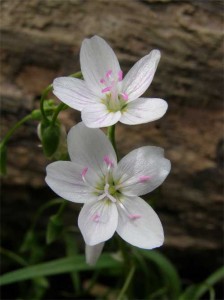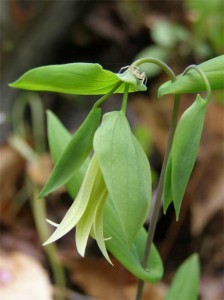There’s still time to catch the boys sporting around in pink

In the upper, younger spring beauty flower, the lady pistil remains closed while the boy stamens strut around. In the lower, older flower, the boys have moved away and the lady is displaying a three-parted crown, preferring pollen from the boys of other flowers. Photo by Ken Moore.
By Ken Moore
Wow, spring beauties’ pink boys are still going strong!
Late this past February, a group of us discovered spring beauty, Claytonia virginica, already in flower, on the slopes and creek bottoms of Carrboro’s Adams Tract. Last week, I followed that same path and found, seven weeks later, mid-April, spring beauties still going strong.
They have passed their peak of flower, but most of them still have buds coming along. I believe this must be the spring wildflower champion for length of bloom time.
Spring beauties have always intrigued me because the stamens, the male parts of a flower, are vivid pink. I am accustomed to stamens being decked out in yellow. I have generally considered pollen to be yellow. Just remember smelling a buttercup or Easter lily and coming away with yellow pollen on your nose. Taking a closer look into the flower of spring beauty is something you won’t forget. And those boys, the stamens, sporting around in pink, are a real curiosity, but your nose doesn’t pick up pink pollen.
I keep pondering pink pollen, but have never, even with a hand lens, detected it, and I’ve never seen yellow pollen on those pink anthers. Finally, this past week, I examined several of those pink-clad boys under a dissecting scope and, behold, there were several open anther sacs revealing almost translucent, pearly-white pollen grains. So my mystery is solved, at least to my satisfaction, and I still marvel at the beauty of the flower.
So if you get out into the woods during this next week, you’ll still have opportunity to spy on those boys sporting around in pink. Don’t put off too long, because with the new leafy tree canopy plunging the forest floor into deep shade, the spring beauties with those thread-thin leaves are bound to consider finishing up for the season.

The yellow lily-like bellwort flower hangs below a perfoliate leaf; a “closer look†reveals a tiny spider lying in wait for a meal. Photo by Ken Moore.
While enjoying the spring beauties, I was happy to spot another common, though not so numerous, spring woodland flower: bellwort, Uvularia perfoliata. The bellworts used to be included in the lily family, but current plant taxonomists have moved them to another. However, it’s still a beautiful little nodding, lily-like flower on a stem of “perfoliate†leaves – i.e., the base of the leaf blade is wrapped completely around the stem of the plant. There are other plants with this characteristic and many of them bear the descriptive Latin species epithet, perfoliata.
The bellwort (and if you take that “closer look†you’ll spy a spider lying in wait, as on so many flowers) is just one of many plants you’ll find showing off right now, as you go in search for a final look at spring beauties. From the tiny emerging heart-shaped leaves of red bud trees to the upright clusters of creamy-yellow flowers of painted buckeyes, you’ll be on sensory overload as you take part in celebrating another Earth Day week. But, hey, we all do that every week, don’t we?!


Comments are closed.